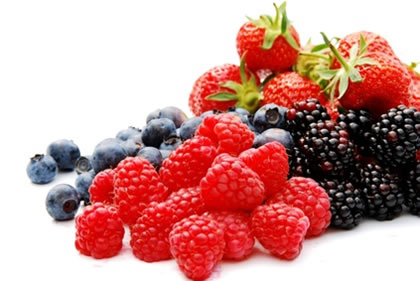Anthocyanin pigments are responsible for the red, purple, and blue colors of many fruits and vegetables. Are a group of different colored pigments where each base color changes as the cell environment changes. Researchers have identified hundreds different anthocyanins, including malvidin, cyanidin, pelargonidin, peonidin and delphinidin. Anthocyanins are believed to display an array of beneficial effects on human health.
Anthocyanins Food Sources
Blueberry, cranberry, bilberry, black raspberry, blackberry, blackcurrant, cherry, strawberrie, purple grapes, red wine, red cabbage, eggplant. Daily intake of total anthocyanins has been estimated to be between 3 and 215 mg/day.
Anthocyanins Benefits
Anthocyanins may help prevent cardiovascular disorders, inflammatory responses, cancer, and degenerative diseases. Anthocyanins also improve neuronal and cognitive brain functions, ocular health as well as protect genomic DNA integrity. In recent years, numerous publications have demonstrated that besides their in vitro antioxidant capacity, certain phenolic compounds, such as anthocyanins, proanthocyanidins, and other flavonoids, may regulate different signaling pathways involved in cell survival, growth and differentiation. Over 600 structurally distinct anthocyanins have been identified.
Antioxidant
As an antioxidant, anthocyanins help rid the body of the free radicals that cause oxidative damage in the body. Anthocyanins and derivatives, protect against a variety of oxidants through a number of mechanisms. Large amounts of free radicals are formed when bodies are exposed to pollution, stress, cigarette smoke, toxic wastes, drugs, aging, and UV radiation. Without antioxidants, we would be prone to numerous diseases and infections.
Anti-Inflammatory
 The anti-inflammatory effects of anthocyanins can help lower the risk of degenerative diseases such as Alzheimer’s, atherosclerosis and osteoporosis. In clinical trial involving 120 patient, those taking 300 mg of an anthocyanin extract daily for three weeks experienced a decrease of between 25% to 60% in many different inflammatory mediators. According to research by “Michigan State University”; indicates tart cherry anthocyanins are at least 10 times more active than Asprin. Ullevaal University Hospital report that a mixture of anthocyanins from bilberries and blackcurrants reduced levels of transcription factor NF-kB.
The anti-inflammatory effects of anthocyanins can help lower the risk of degenerative diseases such as Alzheimer’s, atherosclerosis and osteoporosis. In clinical trial involving 120 patient, those taking 300 mg of an anthocyanin extract daily for three weeks experienced a decrease of between 25% to 60% in many different inflammatory mediators. According to research by “Michigan State University”; indicates tart cherry anthocyanins are at least 10 times more active than Asprin. Ullevaal University Hospital report that a mixture of anthocyanins from bilberries and blackcurrants reduced levels of transcription factor NF-kB.
Anti-Cancer
In the lab, have been found to inhibit some human tumor cells. Delphinidin and cyanidin inhibit epidermal growth factor receptor in cancer cells, while malvidin is less effective. In vitro and in vivo research trials, anthocyanins have demonstrated marked ability to reduce cancer cell proliferation and to inhibit tumor formation. In a study showed that anthocyanins effectively halted colon cancer cell growth, killing 20 percent of the malignant cells without damaging non-cancerous cells. Anthocyanins and anti-cancer mechanisms; 1- Antioxidation effect, 2-the molecular mechanisms involved in anticarcinogenesis, 3-the molecular mechanisms involved in the apoptosis induction of tumor cells.
Cardiovascular Disease
Cardiovascular disease is caused by disorders of the heart and blood vessels, and includes coronary heart disease, cerebrovascular disease, raised blood pressure, peripheral artery disease, congenital heart disease and heart failure. Epidemiological studies suggest that increased consumption of anthocyanins lowers the risk of cardiovascular disease, the most common cause of mortality among human. Anthocyanins have demonstrated anti-oxidative and anti-inflammatory properties, and a high intake of anthocyanin have indicated positive effects on blood pressure and other cardiovascular risk factors. Crude anthocyanin extracts have been administered both orally and via injection to reduce capillary permeability. The anthocyanins cyanidin and delphinidin have been shown to prevent the expression of vascular endothelial growth factor, a compound that has stimulates atherosclerosis. According to a study, which was published in 2004 in the ‘Journal of Biomedicine and Biotechnology’, anthocyanins can protect cardiovascular health from oxidative stress and block the degradation of fat into harmful compounds in blood.
Diabetes
In one German study, 12 diabetic patient took 600 mg anthocyanins daily for two months. At the end of the study, abnormal collagen production was significantly decreased. Is possible that consumption of fruits containing anthocyanins could have a significant impact on insulin levels in humans. Anthocyanins, plant pigments responsible for the colour of many fruits such as blackberries and cherries, increased insulin production in animal pancreatic cells by 50 %, according to the study. Study, published in the January issue of the Journal of Agricultural and Food Chemistry. Retinopathy is a common complication of diabetes. In one study, 30 out of 40 people with retinopathy showed serious improvement after taking 120 mg anthocyanin daily for several weeks. None of the control subjects improved.
Leave a Reply